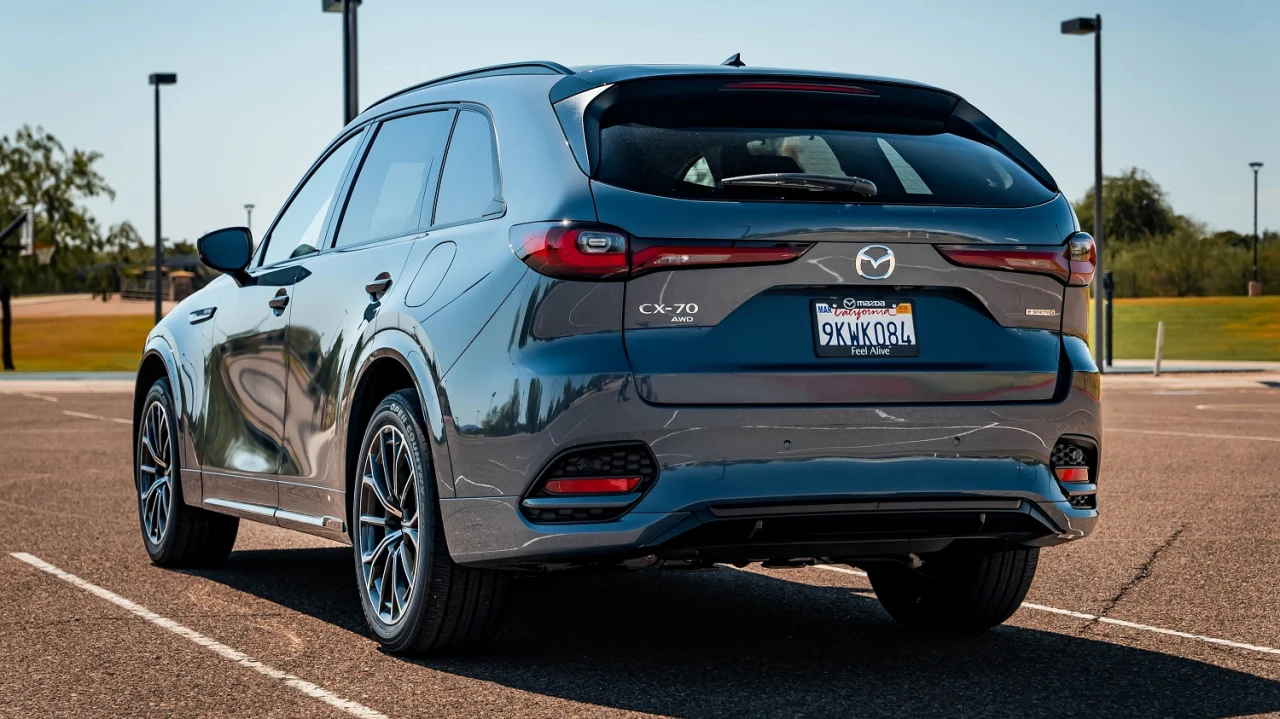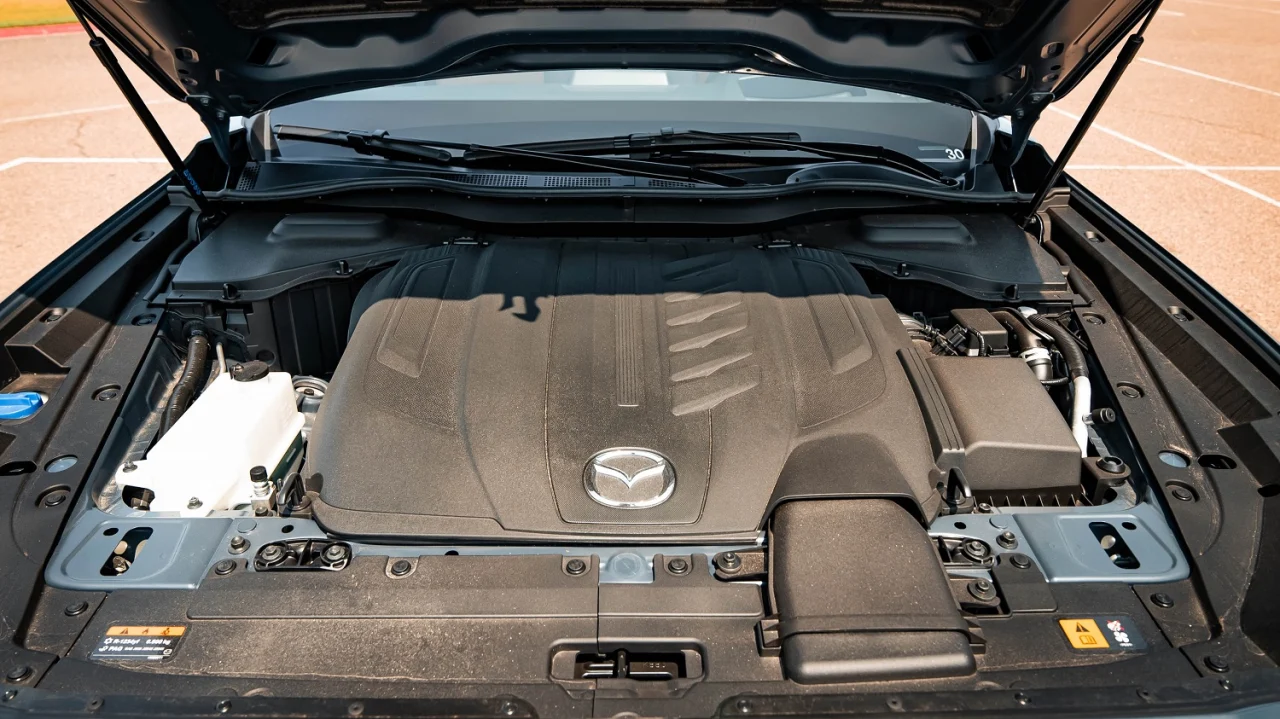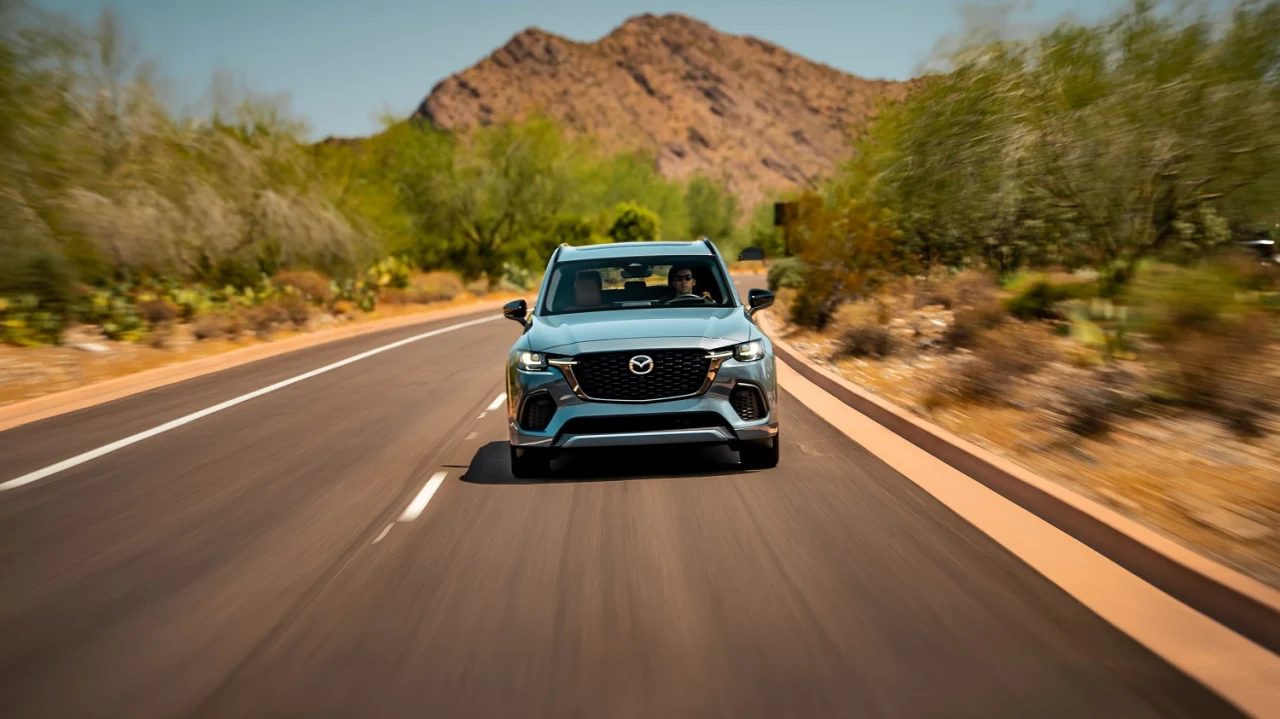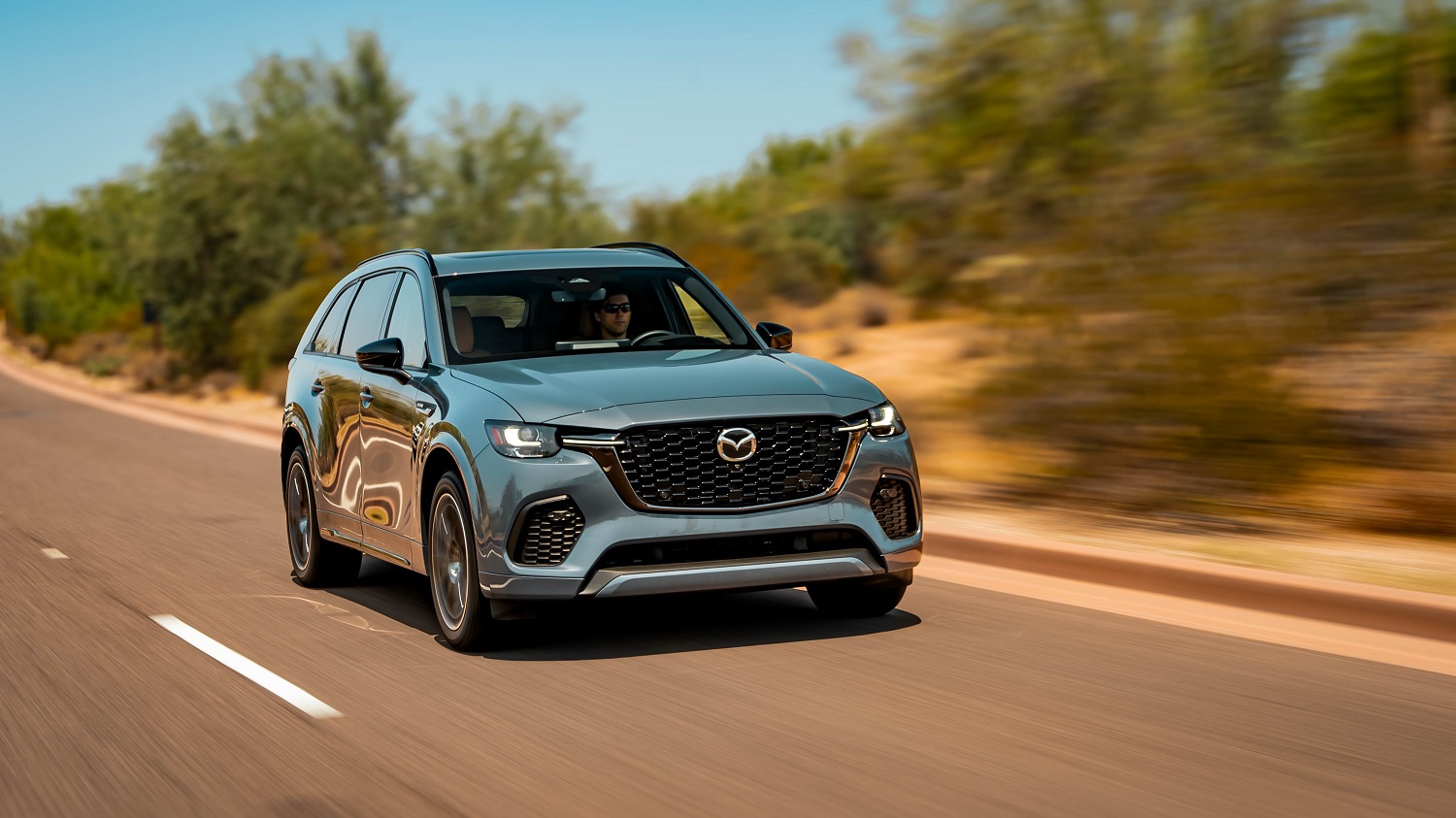In a February 2024 press release for the all-new 2025 CX-70 midsize crossover, Mazda stated it was “engineered to meet the needs of customers in North America.” Specifically, those who use their vehicles as part of enjoying their hobbies and pursuing their passions. That made me curious. What do North American customers need in a vehicle? I started by answering the question myself, then conducted some informal research around my office here in Scottsdale, Arizona by asking three of my coworkers – one from Virginia, one from Minnesota, and one from Canada. That raised another question: Would the 2025 Mazda CX-70 have what it took to meet those requirements?
Mazda offers the CX-70 with two different powertrains. The plug-in hybrid CX-70 has a turbocharged 2.5-liter I4 and an electric motor. There’s also a 48-volt mild hybrid version of the CX-70 that’s available in two states of tune for its turbocharged 3.3-liter I6 and three trim levels. No matter which CX-70 you choose, it comes equipped with rear-biased all-wheel drive and an eight-speed automatic. I got a chance to find out which needs the CX-70 satisfies behind the wheel of a high-output, top-of-the-line 3.3 Turbo S Premium Plus model, which has an MSRP of $55,950. My media loaner had the optional $450 Polymetal Gray Metallic paint, which brought its final price (after delivery, processing, and handling) to $57,775.
Given that the only Mazdas I had driven before were the Mazda3 Hatchback, MX-5 Miata, and CX-5, I was not prepared for the size of the CX-70. I also didn’t realize I didn’t have Mazda’s numbering system completely figured out. It makes sense…to a certain point. As you might think, the CX-70 is larger than the CX-5 and CX-50. However, it’s not bigger than the CX-90. On the outside, the CX-70 and CX-90 have the same 122.8-inch wheelbase, nearly 17-foot length, 85-inch mirror-to-mirror width, and 68-inch height. The main difference is on the inside, where the CX-90 provides three rows of seats instead of the CX-70’s two. Mazda’s designers scaled everything on the outside of the CX-70 appropriately. Between the adaptive LED headlights and turn signals is a prominent grille filled with piano black mesh. The large, heated mirrors are set inside chunky, power-folding housings. My tester rolled on a set of 21-inch wheels with an attractive two-tone machine-cut finish and all-season tires. At the rear, the LED taillights wrap around the rear panels and flow onto the hands-free power liftgate, which can be opened remotely, with the key fob, or by waving a foot under the rear bumper.

As the top trim level, the 3.3 Turbo S Premium Plus comes with a few cosmetic and functional features that set it apart from its siblings. It starts with the Tan Nappa leather seats – the only color available. Mazda uses that same color on the two-tone steering wheel and the suede-like microfiber on the door panels and the middle of the dashboard. That fabric has a nice feel to it, but it makes me wonder what the dash will look like after a few years of sun, dust, fingerprints, and sneezes. Usable upgrades include LED footwell lighting in both rows and a 150-watt outlet in the cargo area.
The list of standard equipment on the flagship CX-70 is impressive. The first row is furnished with heated and ventilated eight-way power seats, a power-adjustable steering column, and a heated steering wheel. Behind that wheel is a head-up display and a 12.3-inch digital gauge cluster, which matches the size of the center screen. Despite how far back that’s set, which implies that it’s only a display, it does function as a touchscreen. Infotainment functions, such as wireless Android Auto and Apple CarPlay and Amazon Alexa (a first in a Mazda crossover) can also be accessed and adjusted with the puck and dial combination on the center console. To the right is the volume knob for the 12-speaker Bose Centerpoint audio system. When I first encountered Mazda’s centrally mounted infotainment controls in a press vehicle several years ago, I hated the setup because I was so used to quickly glancing at a vehicle’s center screen and reaching right next to or below it to adjust the volume. But after riding shotgun next to my wife in her CX-5 for over a year, I now see the convenience in the layout. If either one of us wants to crank up a song, we can quickly do that thanks to the knob that’s right in between us.
In the second row, manual sunshades help keep out some of the intense Arizona summer heat while the pair of HVAC vents connected to the third climate zone combat whatever makes its way into the cabin. I’m 5’10’ and I had plenty of legroom behind the driver’s seat, but if I needed more, all I had to do was manually slide the seat back. For maximum comfort, I also had the option of manually reclining my seat.
With that second row in place, the CX-70 is capable of hauling 39.6 cubic feet of cargo. Pressing the buttons in the cargo bay to remotely lower them increases that figure to 75.3. There’s even more space in the shallow open bins to the sides of the load floor, in a small cavity near the entrance of the cargo area, and in the under-floor tray for the tire iron.

So what about that completely unscientific research I conducted? The three colleagues I asked gave me a variety of different answers, but they all pertained to the interior of a vehicle. Two told me that a comfortable step-in height was a must. Mazda doesn’t have that listed in the specifications on its consumer or media sites. My daily driver is a Hyundai Sonata so I’m used to descending into the driver’s seat, but getting behind the wheel of the CX-70 was easy. Yes, it rides a little higher because it’s a crossover, but I didn’t need an A-pillar grab handle, a running start, or a Sherpa to get seated. Those same two coworkers also expressed the importance of a vehicle’s cargo room. The CX-70’s and CX-90’s similar exterior dimensions translate to their interior measurements. When its third row is down, the CX-90 offers marginally more space behind its middle seats (approximately 40 cubic feet). When both vehicles are in their all-out hauling configurations, the CX-90 falls short (albeit by a nearly microscopic amount) of the CX-70 with 75.2 cubic feet of maximum gear-carrying room. I didn’t get a chance to transport anyone’s bike or IKEA furniture purchases, but I have a feeling my coworkers would find the CX-70’s interior space sufficient. Unfortunately, the CX-70’s rear seats don’t fold completely flat or lock into place, so they wouldn’t have gotten a perfect score from my fellow employees. There was one unanimous response to my question about what a vehicle needs to have: second-row AC vents. I agreed with that wholeheartedly and I was pleased to see the CX-70 had them. In fact, rear vents were one of the features that attracted me to my Sonata.
I spend a lot of time with my wife and my mother-in-law so safety features are also high on my list of must-haves. The CX-70’s suite of technologies that includes Blind Spot Monitoring, Lane-keep Assist, Lane Departure Warning, Rear Cross Traffic Alert, and Head-on Traffic Avoidance Assist gave me peace of mind.

The CX-70’s engine came as a pleasant surprise. In an age in which many manufacturers use turbo I4s for a wide variety of vehicles, Mazda chose to give the mild-hybrid CX-70 an 11-kW electric motor and a turbocharged 3.3-liter inline-six that generates a stout 340 horsepower and 369 lb-ft of torque. Around town, if I left the i-Stop function engaged, it would shut off the engine at stop lights. It was even more noticeable when I was coasting because I’d see the tachometer needle swing down to zero to save as much premium fuel as possible. Under ideal circumstances, my CX-70 tester could return 23 miles per gallon in the city, 28 on the highway, and 23 combined. All of the idling I did as part of shooting the review video with our visionary media director put a big dent in the as-tested fuel economy, taking it down to 21.1 mpg over the course of 395.3 miles. When I wasn’t concerned about how much gas I burned, that I6 was a delight. It pulled strongly and delivered its output through all four wheels smoothly and linearly. The eight-speed automatic was a good match for it and didn’t hesitate to jump down a gear or two when my right foot told it I wanted to get somewhere in a hurry.

Mazda may have gone after a specific customer group with the 2025 CX-70, but the sheer size of North America’s potential crossover buyer base makes it impossible to satisfy every single would-be consumer. With its upscale interior, well-appointed second row, CX-90-rivaling cargo space, and ample straight-six power, the CX-70 3.3 Turbo S Premium Plus met almost all of the needs of a few particular North Americans. Trust me. I did the research.

Comments are closed